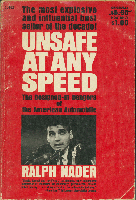
Tough Guys and Pretty Boys:
The Cultural Antagonisms of Engineering and Aesthetics in Automotive History
Contradictions of Fantastic Styling and the Stylists' Fall From Grace
The 1960s, however, brought questions about these dream machines that were part of larger doubts about America's prosperity and its costs. The remarkable success of the auto industry in selling Americans substitute satisfactions for their suppressed desires revealed the contradictions of the system of mass consumption. The more people tried to escape their individual problems in bigger, more powerful dream machines, the more crowded, dangerous, and environmentally devastating the roads became, which prevented all from achieving the escape they sought. The first sign of trouble came in 1958, the year of the Edsel debacle. The Ford company introduced this new car line named after Henry’s now-deceased son to compete in the expanding middle-priced market. In order to stand out in this crowded segment, executives demanded that the Edsel have totally distinctive styling. What Ford stylists produced, however, was a car that merely exaggerated the
styling excesses of the day, with horizontal fins, concave sides, and a peculiar
horizontal grille. The release of the Edsel in the fall of 1957 coincided with
the start of the first postwar economic recession and the launching of the Soviet
Sputnik satellite, both of which raised questions about the nature of America’s consumer economy. In the light of these serious developments, the car seemed silly and self-indulgent. Besides, the Edsel protested its difference so loudly that consumers began to notice that it was really very similar to all the other oversized and overdecorated family sedans Detroit was producing. The slow sales and consequently quick cancellation of the Edsel signaled serious problems in the industry. Another ominous sign of America's growing doubts about its automotive fantasies was the steady rise in sales of the German Volkswagen. The appeal of the VW for many consumers was its real difference. The small, cheap, and unpretentious little car certainly stood out in the sea of gaudy, gargantuan, look-alike sedans produced by Detroit automakers. Many Americans, especially the growing number of countercultural youth in the 1960s, embraced the Volkswagen as the anti-car, a symbolic rejection of the homogeneity, waste, and extravagance of American cars and consumer culture as a whole. Increased sales of the little bug indicated that something was seriously wrong with the assumptions that had driven stylists for thirty years.
In the 1960s Detroit tried to address consumers’ perception of automotive homogeneity by offering an increasing variety of car models. Instead of relying on the artificial differentiation of the same big family sedans, American automakers pioneered structurally and mechanically new auto types, such as the muscle car, the pony car, and the personal luxury car. To compete with the VW and other imports, the Big Three also introduced compacts, and it was the controversy over one of these that galvanized popular sentiment against stylists and Detroit automakers in general. In 1960 GM introduced its Corvair compact, a rear-engined, air-cooled car. But there were problems with the swing-axle rear suspension that caused dangerous oversteer at high speeds and resulted in scores of deaths. This defect was featured in Unsafe at Any Speed, a 1965 book authored by a young auto-safety crusader named Ralph Nader. Nader charged that GM executives knew of the defect and, despite the pleadings of their own engineers, refused to install the $15 stabilizing bar to correct it. His book generally accused the Big Three of being too obsessed with sales and styling to build safe, efficient cars. In a chapter on automotive engineers, Nader argued that they submissively catered to the stylists and merchandisers, who had the real power to determine design. He testified to these facts before a U.S. Senate subcommittee, and when GM executives were caught trying to intimidate him, they and the entire industry were publicly humiliated. What followed was a series of landmark Congressional acts in the late 1960s that established safety and emission standards for cars.
But the real day of reckoning for stylists and their dream machines did not come until 1973, the year of the OPEC oil
embargo. When gas shortages spread and prices soared, Americans got a rude awakening from
their automotive dreams, and for the first time in fifty years concerns for
efficiency and safety assumed priority. In the corporate hierarchies, stylists
got their comeuppance, and the engineers regained the power to design cars in
order to meet new government regulations of emissions, fuel economy, and safety.
But because they were under severe cost restraints, engineers were not very
innovative, giving consumers mainly copies of the econobox cars like the
Volkswagen Rabbit that were flooding the American market from Europe and Japan.
Introduction
The Utilitarian Vision of Henry Ford
General Motors Style Overtakes Ford Efficiency
The Changing American Character
The Struggle for Styling in the Early Industry
The Depression Era Battle for Streamlining
The Triumph of Stylists in the 1950s
Contradictions of Fantastic Styling and the Stylists' Fall From Grace
Stylists Fight Back with "AERO"
Postindustrial Lifestyle Cars & The New Balance of Power Between Engineers and Designers
Complete Text Printable View
©2004 Automobile in American Life and Society



